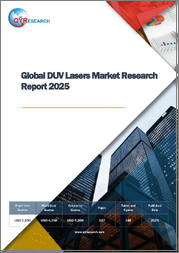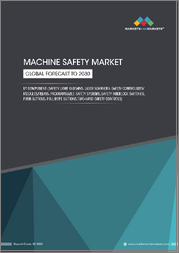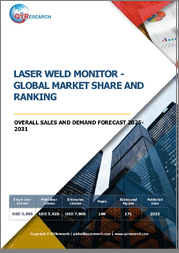
|
시장보고서
상품코드
1615889
세계의 레이저 기술 시장 규모 : 유형별, 용도별, 산업별, 지역별, 범위 및 예측Global Laser Technology Market Size By Type, By Applications, By Industry Vertical, By Geographic Scope And Forecast |
||||||
레이저 기술 시장 규모와 전망
레이저 기술 시장 규모는 2024년 176억 4,000만 달러로 평가되며 2031년에는 269억 1,000만 달러에 달할 것으로 예상되며, 예측 기간인 2024년부터 2031년까지 연평균 5.98%의 성장률을 보일 것으로 예측됩니다.
레이저 기술 세계 시장 촉진요인
레이저 기술 시장의 시장 촉진요인은 다양한 요인의 영향을 받을 수 있습니다.
산업적 응용의 확대:
산업 응용 분야 확대: 레이저는 정밀도와 효율성으로 인해 자동차, 항공우주 및 산업 분야에서 절단, 용접, 마킹, 드릴링 등 다양한 용도로 점점 더 많이 사용되고 있습니다.
의료 용도 개선:
외과, 피부과, 안과, 치과 등 의료 현장에서 레이저 기술이 널리 사용됨에 따라 이들 분야에서는 보다 진보된 레이저 기반 장비가 도입되고 있어 시장 확대가 예상됩니다.
통신 및 데이터 스토리지의 수요:
레이저는 5G 기술의 출현과 데이터 저장 장치에 대한 수요가 증가함에 따라 통신 네트워크, 데이터센터 및 광학 저장 장치에 없어서는 안 될 필수 요소입니다.
국방 및 국토안보의 필요성:
표적 식별, 미사일 방어, 레이저 무기 개발과 같은 국방 응용 분야는 레이저 기술에 크게 의존하고 있으며, 국방비 지출이 시장 확대를 주도하고 있습니다.
환경과 에너지에 대한 응용:
지속가능성을 촉진하기 위한 국제적인 노력에 따라 레이저는 오염 제어, 환경 모니터링, 재생에너지원(예: 태양전지판)을 생성하는 데 사용되고 있습니다.
기술의 진보:
새로운 파장, 더 높은 출력, 더 짧은 펄스 시간 등 레이저 기술의 끊임없는 발전은 응용 범위를 확장하고 추가 연구 개발을위한 자금을 모으고 있습니다.
비용 절감 및 시장 진입:
제조 비용이 낮아지고 레이저 기술이 더 널리 보급되면 더 많은 경제 부문과 기업이 레이저 기반 솔루션을 구매하고 사용할 수 있게 되어 시장 성장을 촉진할 수 있습니다.
소형화 및 통합:
레이저 시스템의 소형화, 휴대화, 통합화가 진행됨에 따라 가전제품, 의료기기, 핸드헬드 공구 등에 널리 사용되어 다양한 산업에서 수요가 발생하고 있습니다.
레이저 기술 세계 시장 억제요인
레이저 기술 시장에는 몇 가지 요인이 억제요인과 도전으로 작용할 수 있습니다. 다음은 그 중 한 가지 예입니다.
높은 초기 투자 비용:
높은 초기 투자 비용: 중소기업과 신생 기업은 인프라, 장비, 훈련된 인력에 대한 막대한 초기 투자가 필요하기 때문에 레이저 기술을 도입하기 어렵습니다.
복잡성 및 유지보수:
최적의 성능을 보장하기 위해 레이저 시스템은 종종 복잡하고 정기적인 유지보수 및 교정을 받아야 하는 경우가 많습니다. 이러한 복잡성은 특히 기술 노하우가 부족한 기업의 경우 운영 비용과 다운타임을 증가시킬 수 있습니다.
규제 및 안전 규정 준수:
레이저 기술은 제조, 의료, 국방 등 다양한 산업에서 사용되고 있으며, 배출, 안전 및 사용에 대한 엄격한 규제를 준수해야 합니다. 이러한 조건을 충족하는 경우, 레이저 솔루션의 채택은 더 복잡하고 비용이 많이 들게 됩니다.
대안 기술과의 경쟁:
비 레이저 기반 시스템, 화학 공정 및 전통적인 가공 기술은 레이저 기술이 직면한 대체 기술 중 일부입니다. 이러한 옵션의 유효성과 경제성은 시장 도입을 방해할 수 있습니다.
제한된 재료 적합성:
특정 산업에서 레이저 시스템의 적응성과 상업적 수용성은 특정 재료를 처리할 수 없거나 추가 처리 단계가 필요하기 때문에 영향을 받을 수 있습니다.
환경에 대한 우려:
레이저 기술은 열, 소음 및 오염 물질을 발생시킬 수 있으며, 특히 민감한 장소나 규제된 장소에서는 환경 및 규정 준수 측면에서 문제가 될 수 있습니다.
기술 격차:
고급 레이저 시스템을 유지 및 운영하려면 전문적인 지식과 훈련이 필요합니다. 레이저 기술 분야에서 자격을 갖춘 인력의 부족은 시장 성장과 보급에 걸림돌이 될 수 있습니다.
시장 세분화:
다양한 기업이 다양한 레이저 제품 및 솔루션을 제공함에 따라 레이저 기술 시장은 단편화되어 있습니다. 가격 압력, 표준화 부족, 다양한 레이저 시스템 간의 상호 운용성 촉진은 이러한 단편화로 인해 발생할 수 있습니다.
목차
제1장 세계의 레이저 기술 시장 소개
- 시장 개요
- 조사 범위
- 가정
제2장 주요 요약
제3장 Verified Market Intelligence 조사 방법
- 데이터 마이닝
- 검증
- 1차 자료
- 데이터 소스 리스트
제4장 레이저 기술 세계 시장 전망
- 개요
- 시장 역학
- 성장 촉진요인
- 성장 억제요인
- 기회
- Porter's Five Forces 모델
- 밸류체인 분석
제5장 레이저 기술 세계 시장, 유형별
- 개요
- YAG 레이저
- 액체 레이저
- 가스 레이저
제6장 레이저 기술 세계 시장 : 업계별
- 개요
- 상업
- 통신
- 반도체·일렉트로닉스
- 자동차
- 헬스케어
- 기타
제7장 레이저 기술 세계 시장, 용도별
- 개요
- 광통신
- 레이저 가공
- 기타
제8장 레이저 기술 세계 시장 : 지역별
- 개요
- 북미
- 미국
- 캐나다
- 멕시코
- 유럽
- 독일
- 영국
- 프랑스
- 기타 유럽
- 아시아태평양
- 중국
- 일본
- 인도
- 기타 아시아태평양
- 세계 기타 지역
- 라틴아메리카
- 중동 및 아프리카
제9장 세계의 레이저 기술 시장 경쟁 구도
- 개요
- 각사의 시장 점유율
- 벤더 상황
- 주요 발전 전략
제10장 기업 개요
- IPG Photonics Corp.
- Coherent, Inc.
- Trumpf Group
- Jeanoptik AG
- Quantel Group
- LasaerStar Technologies Corp.
- Novanta Inc
- Lumentum Holdings Inc.
- Epilog Laser
- Han's Laser Technology Industry Group
- MKS Instruments
제11장 부록
- 관련 보고서
Laser Technology Market Size And Forecast
Laser Technology Market size was valued at USD 17.64 Billion in 2024 and is projected to reach USD 26.91 Billion by 2031 , growing at a CAGR of 5.98% during the forecasted period 2024 to 2031. Global Laser Technology Market Drivers The market drivers for the Laser Technology Market can be influenced by various factors. These may include:
Growing Industrial Applications:
Because of their accuracy and efficiency, lasers are being used more and more in the automotive, aerospace, and industrial industries for cutting, welding, marking, and drilling.
Improvements in Medical Applications:
As these fields continue to adopt more sophisticated laser-based equipment, the market is expected to rise due to the widespread usage of laser technology in medical operations such as surgery, dermatology, ophthalmology, and dentistry.
Demand in Communication and Data Storage:
Lasers are essential for communication networks, data centres, and optical storage systems due to the emergence of 5G technology and the growing need for data storage.
Needs for Defence and Homeland Security:
Defence applications like target identification, missile defence, and the development of laser weapons depend heavily on laser technology, which is driving market expansion due to defence spending.
Environmental and Energy Applications:
In line with international efforts to promote sustainability, lasers are used in pollution control, environmental monitoring, and the generation of renewable energy sources (such as solar panels).
Technological Advancements:
Constant advancements in laser technology, such as new wavelengths, higher power outputs, and shorter pulse durations, increase application scope and draw funding for further study and development.
Cost Reduction and Market Accessibility:
As production costs come down and laser technology becomes more widely available, more sectors of the economy and companies will be able to purchase and use laser-based solutions, which will drive market growth.
Miniaturisation and Integration:
As laser systems become more compact, portable, and integrated, they are used more widely in consumer electronics, medical equipment, and handheld tools, which is creating demand from a variety of industries.
Global Laser Technology Market Restraints
Several factors can act as restraints or challenges for the Laser Technology Market. These may include:
High Initial Investment Costs:
Small and medium-sized businesses (SMEs) and startups may find it difficult to adopt laser technology since it frequently necessitates a large initial investment in infrastructure, equipment, and trained personnel.
Complexity and Maintenance:
In order to guarantee optimal performance, laser systems, which are frequently complicated, need to undergo routine maintenance and calibration. This intricacy can raise operating expenses and downtime, particularly for businesses with little technological know-how.
Regulatory and Safety Compliance:
Laser technology is used in a variety of industries, including manufacturing, healthcare, and defence, and it must adhere to strict regulations about emissions, safety, and use. Adopting laser solutions becomes more complex and expensive when these conditions are met.
Competition from Alternative Technologies:
Non-laser-based systems, chemical processes, and conventional machining techniques are some of the alternatives that laser technology faces off against. The efficacy and affordability of these options may prevent market adoption.
Limited Material Compatibility:
The adaptability and commercial acceptance of some laser systems in specific industries may be impacted by their inability to handle certain materials or by the need for extra processing stages.
Environmental Concerns:
Laser technology has the potential to produce heat, noise, and pollutants that could be problematic for the environment and for regulatory compliance, especially in locations that are sensitive or regulated.
Skills Gap:
Specialised knowledge and training are needed for the upkeep and operation of sophisticated laser systems. The lack of qualified workers in the laser technology sector may be a barrier to market growth and uptake.
Market Fragmentation:
A variety of companies provide a broad range of laser products and solutions, resulting in a fragmented market for laser technology. Price pressures, a lack of standardisation, and difficulties facilitating interoperability among various laser systems might result from this fragmentation.
Global Laser Technology Market Segmentation Analysis
The Global Laser Technology Market is segmented on the basis of Type, Applications, Industry Vertical, and Geography.
Laser Technology Market, By Type
- YAG Laser
- Liquid Laser
- Gas Laser
Based on Type, the market is bifurcated into Liquid Laser, YAG Laser, and Gas Laser. The gas laser category is expected to account for the greatest proportion of the market. This kind will be dominated by CO2 lasers. The characteristics can be ascribed to greater speed, which allows for more efficient and productive labor. Gas lasers have gained popularity due to their small size, ability to work with a wide variety of wavelengths, and use in laser cutting, welding, structuring, perforating, drilling, and laser marking applications.
Laser Technology Market, By Applications
- Optical Communication
- Laser Processing
- Others
Based on Applications, The market is bifurcated into Laser Processing, Optical Communication, and Others. The laser processing application category is expected to dominate the market. Its capacity to produce greater quality, more dependability, and more exact output than traditional mechanical processes can be due to these aspects.
Laser Technology Market, By Industry Vertical
- Commercial
- Telecommunication
- Semiconductor & Electronics
- Automotive
- Healthcare
- Others
Based on Industry Vertical, the market is bifurcated into Commercial, Automotive, Semiconductor & Electronics, Telecommunications, Healthcare, and Others. The telecommunications sector is expected to have the highest market share. The potential of laser technology to offer quick and secure data transfer while consuming less power is a factor that may be attributed to the telecommunications sector. The user can benefit from more efficient and greater bandwidth transmission thanks to laser technology.
Laser Technology Market, By Geography
- North America
- Europe
- Asia Pacific
- Rest of the world
Based on regional analysis, the global Laser Technology Market is classified into North America, Europe, Asia Pacific, and the Rest of the world. The Asia Pacific is expected to account for the greatest market share in the forecasted period. The primary contributors to the growth of the Laser Technology Market are China, India, South Korea, and Japan. The market for this area is being boosted by continued expenditures in research and development activities, a large population base, and increased demand for cost-effective and rapid processing laser machine tools from semiconductors, automotive, and telecommunications.
Key Players
- The major players in the Laser Technology Market are:
- IPG Photonics Corp.
- Coherent Inc.
- Trumpf Group
- Jeanoptik AG
- Quantel Group
- LasaerStar Technologies Corp.
- Novanta Inc
- Lumentum Holdings Inc.
- Epilog Laser
- Han's Laser Technology Industry Group
- MKS Instruments
- GSI Group Inc.
TABLE OF CONTENTS
1 INTRODUCTION OF GLOBAL LASER TECHNOLOGY MARKET
- 1.1 Overview of the Market
- 1.2 Scope of Report
- 1.3 Assumptions
2 EXECUTIVE SUMMARY
3 RESEARCH METHODOLOGY OF VERIFIED MARKET RESEARCH
- 3.1 Data Mining
- 3.2 Validation
- 3.3 Primary Interviews
- 3.4 List of Data Sources
4 GLOBAL LASER TECHNOLOGY MARKET OUTLOOK
- 4.1 Overview
- 4.2 Market Dynamics
- 4.2.1 Drivers
- 4.2.2 Restraints
- 4.2.3 Opportunities
- 4.3 Porters Five Force Model
- 4.4 Value Chain Analysis
5 GLOBAL LASER TECHNOLOGY MARKET, BY TYPE
- 5.1 Overview
- 5.2 YAG Laser
- 5.3 Liquid Laser
- 5.4 Gas Laser
6 GLOBAL LASER TECHNOLOGY MARKET, BY INDUSTRY VERTICAL
- 6.1 Overview
- 6.2 Commercial
- 6.3 Telecommunication
- 6.4 Semiconductor & Electronics
- 6.5 Automotive
- 6.6 Healthcare
- 6.7 Others
7 GLOBAL LASER TECHNOLOGY MARKET, BY APPLICATIONS
- 7.1 Overview
- 7.2 Optical Communication
- 7.2 Laser Processing
- 7.3 Others
8 GLOBAL LASER TECHNOLOGY MARKET, BY GEOGRAPHY
- 8.1 Overview
- 8.2 North America
- 8.2.1 U.S.
- 8.2.2 Canada
- 8.2.3 Mexico
- 8.3 Europe
- 8.3.1 Germany
- 8.3.2 U.K.
- 8.3.3 France
- 8.3.4 Rest of Europe
- 8.4 Asia Pacific
- 8.4.1 China
- 8.4.2 Japan
- 8.4.3 India
- 8.4.4 Rest of Asia Pacific
- 8.5 Rest of the World
- 8.5.1 Latin America
- 8.5.2 Middle East and Africa
9 GLOBAL LASER TECHNOLOGY MARKET COMPETITIVE LANDSCAPE
- 9.1 Overview
- 9.2 Company Market Share
- 9.3 Vendor Landscape
- 9.4 Key Development Strategies
10 COMPANY PROFILES
- 10.1 IPG Photonics Corp.
- 10.1.1 Overview
- 10.1.2 Financial Performance
- 10.1.3 Product Outlook
- 10.1.4 Key Developments
- 10.2 Coherent, Inc.
- 10.2.1 Overview
- 10.2.2 Financial Performance
- 10.2.3 Product Outlook
- 10.2.4 Key Developments
- 10.3 Trumpf Group
- 10.3.1 Overview
- 10.3.2 Financial Performance
- 10.3.3 Product Outlook
- 10.3.4 Key Developments
- 10.4 Jeanoptik AG
- 10.4.1 Overview
- 10.4.2 Financial Performance
- 10.4.3 Product Outlook
- 10.4.4 Key Developments
- 10.5 Quantel Group
- 10.5.1 Overview
- 10.5.2 Financial Performance
- 10.5.3 Product Outlook
- 10.5.4 Key Developments
- 10.6 LasaerStar Technologies Corp.
- 10.6.1 Overview
- 10.6.2 Financial Performance
- 10.6.3 Product Outlook
- 10.6.4 Key Developments
- 10.7 Novanta Inc
- 10.7.1 Overview
- 10.7.2 Financial Performance
- 10.7.3 Product Outlook
- 10.7.4 Key Developments
- 10.8 Lumentum Holdings Inc.
- 10.8.1 Overview
- 10.8.2 Financial Performance
- 10.8.3 Product Outlook
- 10.8.4 Key Developments
- 10.9 Epilog Laser
- 10.9.1 Overview
- 10.9.2 Financial Performance
- 10.9.3 Product Outlook
- 10.9.4 Key Developments
- 10.10 Han's Laser Technology Industry Group
- 10.10.1 Overview
- 10.10.2 Financial Performance
- 10.10.3 Product Outlook
- 10.10.4 Key Developments
- 10.11 MKS Instruments
- 10.11.1 Overview
- 10.11.2 Financial Performance
- 10.11.3 Product Outlook
- 10.11.4 Key Developments
11 Appendix
- 11.1 Related Reports



















